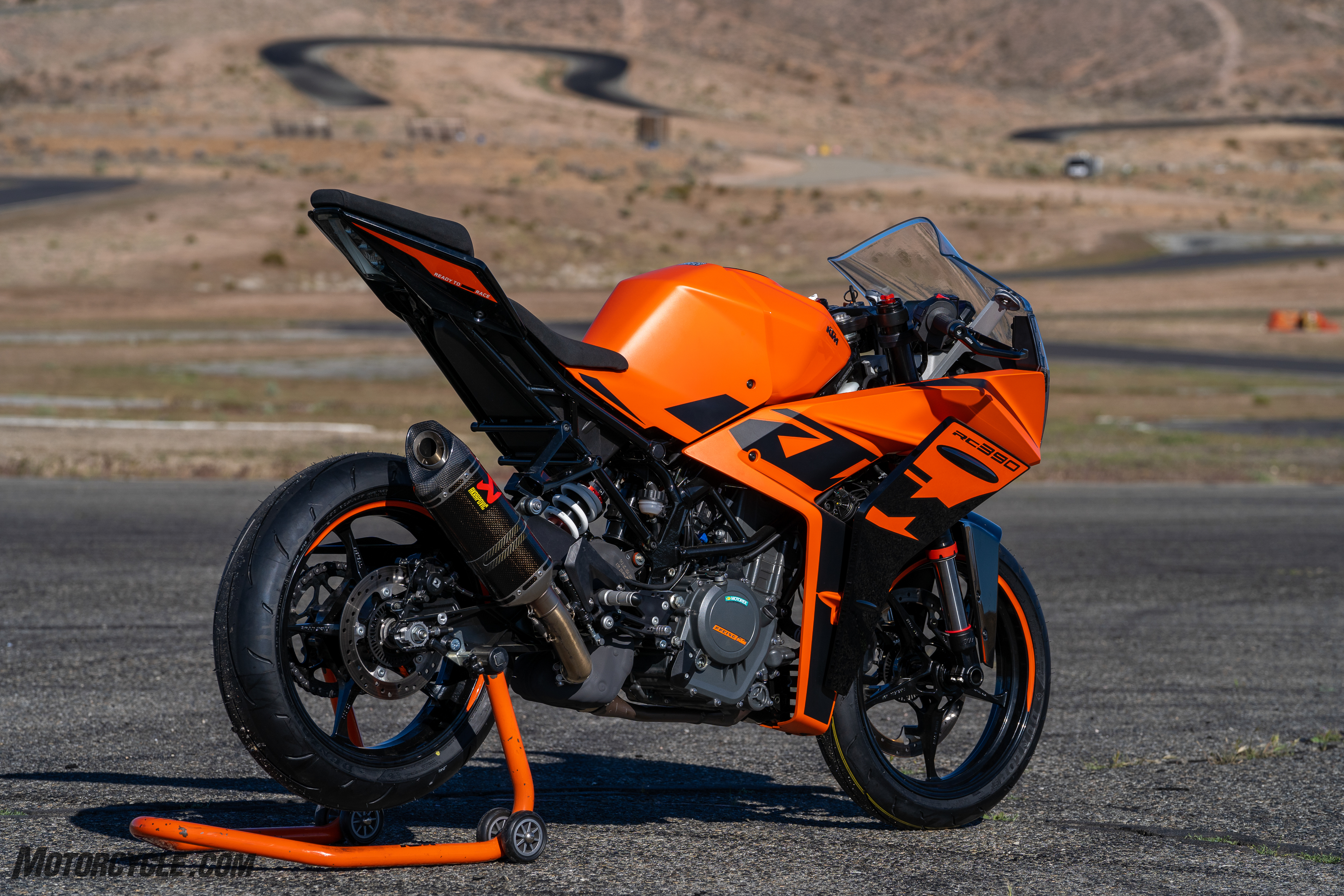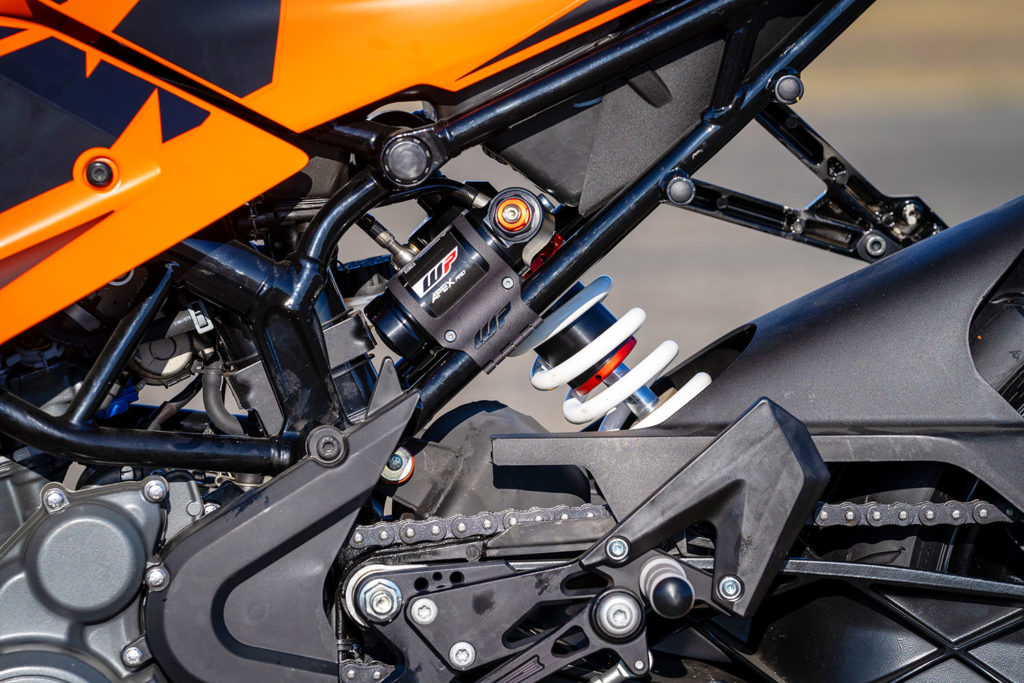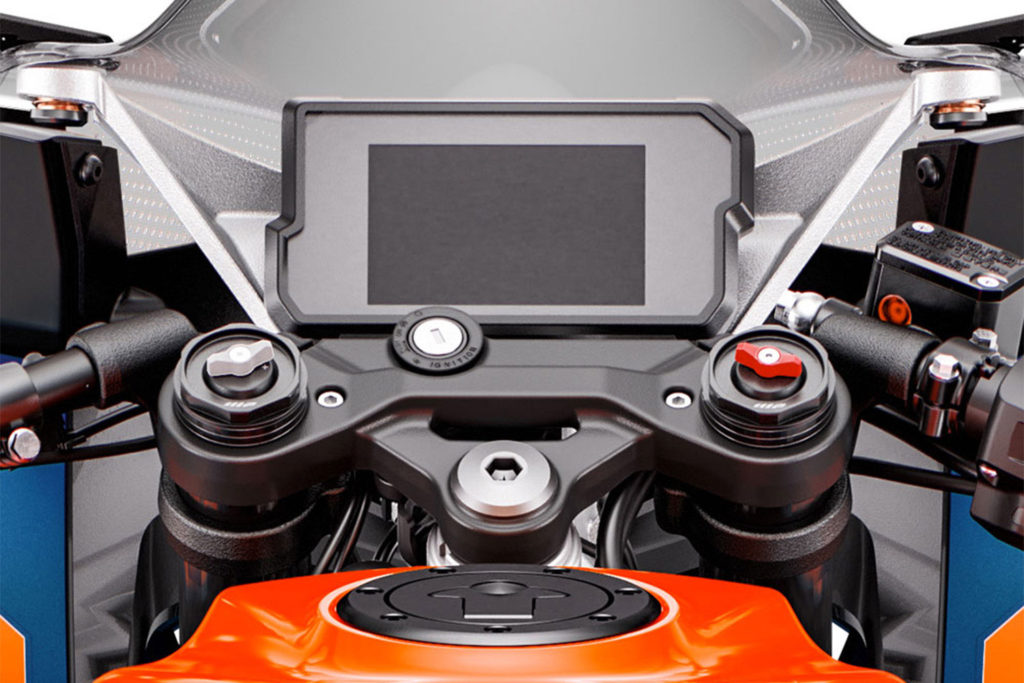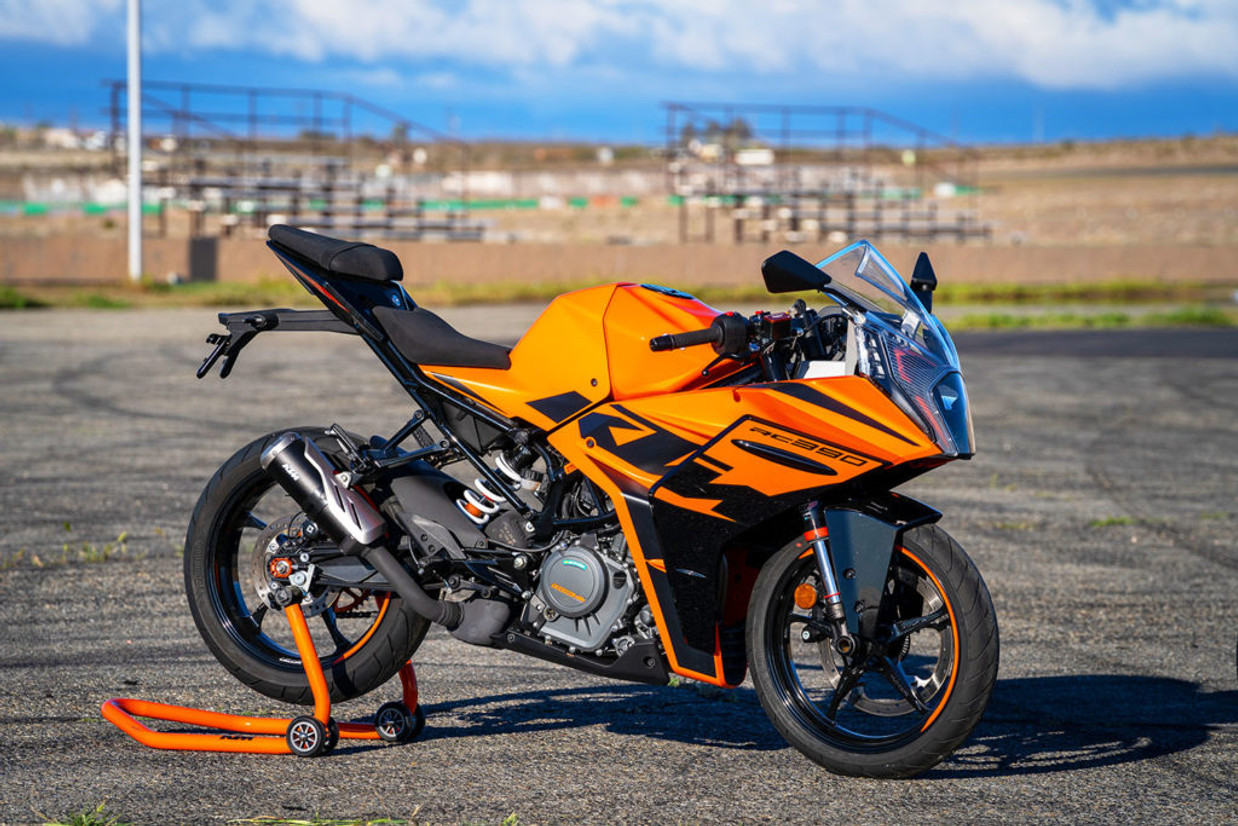All New 2022 KTM RC390 Motorcycle Review & Specs (video included)
For 2022, the KTM RC390 has been reimagined and revised to deliver better sport and track focused performance than ever before. KTM has borrowed many of the features and tech from their 390 Duke and in addition, KTM has managed to shave off 7.5 pounds of extra mass thanks to their new wheels and brake rotors. Aerodynamics were reconfigured to provide better wind protection and to better optimize a rider’s ability to move around on the motorcycle. The result is a physically larger looking motorcycle with an all new stylish look and a larger, differently shaped fuel tank.
KTM left the RC’s liquid-cooled DOHC 373cc single-cylinder engine relatively unchanged to sustain European A2 license eligibility, implementing a short list of improvements to meet new, stricter Euro 5 standards. The RC 390 gets an all-new exhaust system, revised fueling, and a 40-percent-larger airbox. The result is a slight 1.5-pound-foot boost in torque, to 27.3 pound-feet at 7,000 rpm.
Most of the RC 390′s updates focus on handling. KTM optimized the lateral rigidity of the RC’s steel trellis frame and bolt-on subframe, saving 3.3 pounds in the process. More weight savings comes in the form of trick lightweight “open hub” wheels, which are 7.5 pounds (30 percent) lighter than before, for a big reduction of weight. The 390 is also upgraded with a new fork from KTM-owned WP, featuring compression and rebound damping adjustment. The Apex shock is adjustable for spring preload and rebound damping, rare luxuries indeed for the lightweight segment.
With the adjustable WP Apex fork and shock, the rider not only has suspension that is set up better from the start, but also has equipment that is more easily adjustable to suit rider preferences. The compression and rebound adjustable fork withstood all the braking force I was able to generate at the track and maintained composure for the duration. The shock, with its preload and rebound adjustment, also maintained balanced performance. Despite its quick handling, the RC390 manages to keep things confidently stable.

While the weight savings from the wheels is substantial, KTM also managed to shave 3.3 pounds from the frame. Even with this weight savings modifications, the new RC is actually six pounds heavier than the previous generation. The new trellis frame now features a bolt-on subframe and passenger footpegs. In addition, and also keeping with its sporting ethos, the 2022 RC has multiple braces within the frame that can be added or removed to tailor torsional rigidity – a feature to allow the ultimate tuning of chassis flex not before seen in this category. Previously, these braces had been welded together. Former TT racer and chief product designer of the new RC390, Shaun Anderson, saw this as an opportunity to provide a further level of tuning that would make the bike even more Ready to Race.
The suspension held up well on track and the chassis design made the RC390 so easy to maneuver that it took some getting used to for me to not turn in too early. The new front rotor design is reminiscent of Buell’s perimeter rotor in that much of the center is removed for weight savings. The 320mm disc, together with the four-piston fixed Bybre caliper, provides excellent stopping power with plenty of initial bite. Both levers are also span-adjustable.

ABS and TC are now IMU-based in this latest RC390. Similar to that seen on the 390 Duke, ABS can no longer be switched off, but you do get “supermoto” mode that allows the rear ABS to be deactivated. Traction control can be switched off. Hardcore track enthusiasts may be rolling their eyes at the inability to switch off ABS entirely, but it may be less of a concern than one might think.
KTM left the engine and transmission relatively unchanged with some minor updates within the engine for durability (ones that KTM reps couldn’t or wouldn’t explain to me), and the option of an up/down quickshifter to the transmission. Mapping however, was substantially changed thanks to an airbox/exhaust redesign that is said to flow 40% more air. KTM tells us this results in a claimed 44 hp and 27 lb-ft of torque. As before, the RC390 pulls hard right up to its 10,000 rpm redline with the rev-limiter coming in hard and fast.

Ergonomically, the KTM still offers a wider, more open cockpit than the tighter sit-up-and-beg position of the Kawasaki Ninja 400. The KTM RC390 is a more canted forward, sporty riding position, with wider, height adjustable (10mm) handlebars, 32.5 inch seat height, and fairly low stock footpegs make for a really comfortable ride. The RC390 is a comfortable motorcycle for a full day of errand running.
Also, in an unusual departure from the norm, the quickshifter (which is software-based rather than a linkage type) seems to shift better at mid-rpm than closer to redline around town.
(video credits: 44Teeth)
Despite the engine feeling that it has lost some of its low-end, the RC390 is still a fun lightweight machine to hustle around city streets. The fairing and riding position aren’t too extreme to cause discomfort and are just about perfect for keeping the weight off of your wrists during prolonged freeway blasts at speeds of 80 mph and above. The seat is also much more comfortable than previous iterations we’ve perched upon, including the 390 Duke. KTM tells us the seat foam is double the thickness from before and features a new cover which also provides a nice amount of grip.
| 2022 KTM RC390 Specs: | |
|---|---|
| Engine Type | Liquid cooled, Single-cylinder, 4-stroke DOHC four-valve engine |
| Displacement | 373cc |
| Bore x Stroke | 89 mm x 60 mm |
| Compression Ratio | |
| Horsepower | 40.1 hp at 9,000 rpm (measured) |
| Torque | 24.1 lb-ft. at 8,400 (measured) |
| Starter | Electric starter |
| Clutch | PASC antihopping clutch, mechanically operated |
| Transmission | 6-speed |
| Chain | 520 X-Ring |
| EMS | Bosch EMS with RBW |
| Lubrication | Wet sump |
| Frame | Powder-coated steel lattice |
| Front Suspension | WP APEX 3343 inverted fork with adjustable compression and rebound damping; 4.7 inches of travel |
| Rear Suspension | WP APEX 3446 monoshock with adjustable spring preload and rebound damping; 5.9 inches of travel |
| Front Brake | Four-piston radial fixed caliper, single 320 mm disc |
| Rear Brake | Single-piston floating caliper, 230 mm |
| ABS | Bosch 9.1MP Two Channel ABS (Supermoto ABS) |
| Front Wheel | Cast five-spoke wheel |
| Rear Wheel | Cast five-spoke wheel |
| Front Tire | 110/70 R 17 M/C 54V TL Continental ContiRoad |
| Rear Tire | 150/60 R 17 M/C 66V TL Continental ContiRoad |
| Fuel Capacity | 3.6 gallons |
| Seat Height | 32.4 inches |
| Ground Clearance | 6.2 inches |
| Wheelbase | 52.8 inches |
| Rake / Trail | 23.5° / 3.3 inches |
| Wet Weight | 362 pounds (measured) |
| Service Intervals | 9,300 miles |
Recent Posts
-
How to Decode the Many Harley Davidson Acronyms, Models, Codes, & Styles
Harley Davidson has A LOT of models, acronyms, and different style bikes which can lead to plenty of
-
Have You Seen the Limited Edition 2023 Jack Daniel's Indian Chief Bobber Dark Horse? -Check Out the Full Review with video included
Since 2018, Jack Daniel's and Indian Motorcycle have developed a successful partnership together. Wi



